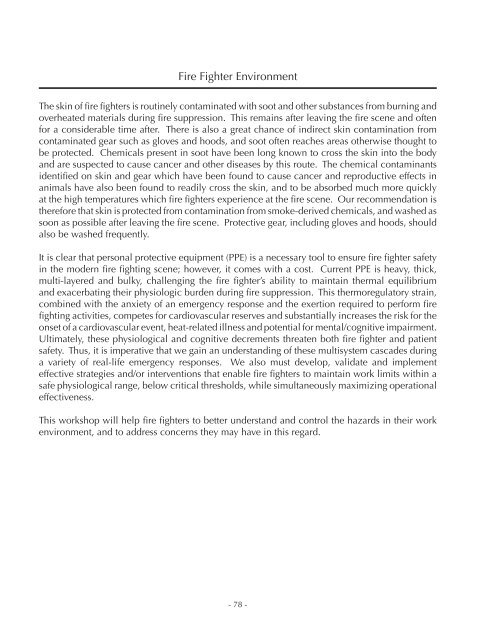Redmond EMS Abstracts.indd - IAFF
Redmond EMS Abstracts.indd - IAFF
Redmond EMS Abstracts.indd - IAFF
You also want an ePaper? Increase the reach of your titles
YUMPU automatically turns print PDFs into web optimized ePapers that Google loves.
Fire Fighter Environment<br />
The skin of fire fighters is routinely contaminated with soot and other substances from burning and<br />
overheated materials during fire suppression. This remains after leaving the fire scene and often<br />
for a considerable time after. There is also a great chance of indirect skin contamination from<br />
contaminated gear such as gloves and hoods, and soot often reaches areas otherwise thought to<br />
be protected. Chemicals present in soot have been long known to cross the skin into the body<br />
and are suspected to cause cancer and other diseases by this route. The chemical contaminants<br />
identified on skin and gear which have been found to cause cancer and reproductive effects in<br />
animals have also been found to readily cross the skin, and to be absorbed much more quickly<br />
at the high temperatures which fire fighters experience at the fire scene. Our recommendation is<br />
therefore that skin is protected from contamination from smoke-derived chemicals, and washed as<br />
soon as possible after leaving the fire scene. Protective gear, including gloves and hoods, should<br />
also be washed frequently.<br />
It is clear that personal protective equipment (PPE) is a necessary tool to ensure fire fighter safety<br />
in the modern fire fighting scene; however, it comes with a cost. Current PPE is heavy, thick,<br />
multi-layered and bulky, challenging the fire fighter’s ability to maintain thermal equilibrium<br />
and exacerbating their physiologic burden during fire suppression. This thermoregulatory strain,<br />
combined with the anxiety of an emergency response and the exertion required to perform fire<br />
fighting activities, competes for cardiovascular reserves and substantially increases the risk for the<br />
onset of a cardiovascular event, heat-related illness and potential for mental/cognitive impairment.<br />
Ultimately, these physiological and cognitive decrements threaten both fire fighter and patient<br />
safety. Thus, it is imperative that we gain an understanding of these multisystem cascades during<br />
a variety of real-life emergency responses. We also must develop, validate and implement<br />
effective strategies and/or interventions that enable fire fighters to maintain work limits within a<br />
safe physiological range, below critical thresholds, while simultaneously maximizing operational<br />
effectiveness.<br />
This workshop will help fire fighters to better understand and control the hazards in their work<br />
environment, and to address concerns they may have in this regard.<br />
- 78 -

















